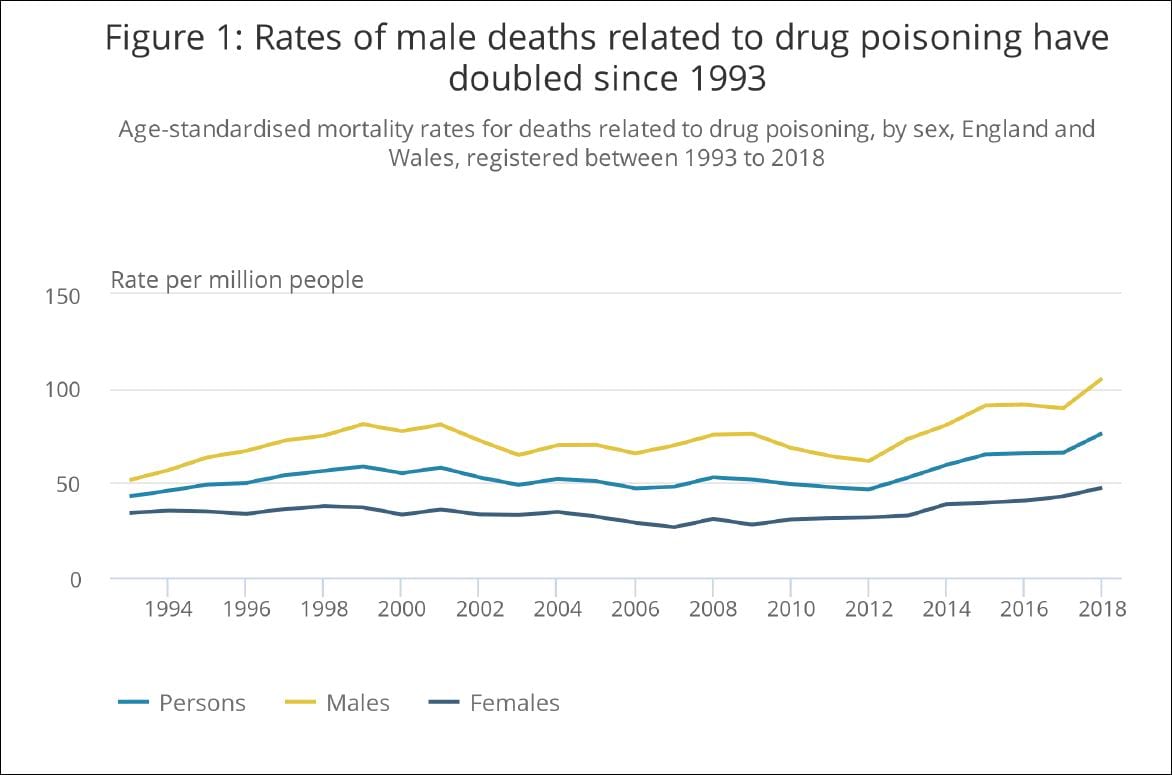The Office for National Statistics today published the dreaded annual figure for the number of drug-related deaths for England and Wales.
The figures are for 2018 and are even worse than feared: There were 4,359 deaths related to drug poisoning in England and Wales in 2018, the highest number and the highest annual increase (16%) since records began.
The other main findings make for equally distressing reading:
- The male drug poisoning rate has significantly increased from 89.6 per million males in 2017 to 105.4 in 2018; while the female rate increased for the ninth consecutive year to 47.5 per million females in 2018, the latest increase was not statistically significant compared to 2017.
- Two-thirds (or 2,917) of drug-related deaths were related to drug misuse, accounting for 50.9 deaths per million people in 2018.
- The North East had a significantly higher rate of deaths relating to drug misuse than all other English regions; London had the lowest rate.
- Between 2017 and 2018, there were increases in the number of deaths involving a wide range of substances, though opiates, such as heroin and morphine, continued to be the most frequently mentioned type of drug.
- Deaths involving cocaine doubled between 2015 and 2018 to their highest ever level, while the numbers involving new psychoactive substances (NPS) returned to their previous levels after halving in 2017.
The substantial rises in the number of drug-related deaths over recent years have been linked to the increasing number of older, long-term heroin users with a range of complex needs. However, the most recent figures set policy makers and treatment providers a broader range of challenges with increases in deaths relating to both cocaine and new psychoactive substances/legal highs.
Definitions
For each year in the last decade, around two-thirds of drug poisoning deaths were from drug misuse.
Drug poisoning deaths involve a broad spectrum of substances, including controlled and non-controlled drugs,
prescription medicines (either prescribed to the individual or obtained by other means) and over-the-counter
medications. As well as deaths from drug abuse and dependence, figures include accidents and suicides involving drug poisonings, and complications of drug abuse such as deep vein thrombosis or septicaemia from intravenous drug use. They do not include other adverse effects of drugs, for example, anaphylactic shock, or accidents caused by an individual being under the influence of drugs. More than half of all drug poisoning deaths involve more than one drug and sometimes also alcohol, and it is often not possible to tell which substance was primarily responsible for the death.
Drug misuse deaths are defined as a death where either the underlying cause is drug abuse or drug dependence, or the underlying cause is drug poisoning and any of the substances controlled under the Misuse of Drugs Act 1971 are involved.
2018 follows a similar pattern, with 2,917 deaths relating to drug misuse, out of a total of 4,359 drug poisoning deaths.
Age
In 2018, those aged between 40 and 49 years had the highest age-specific drug misuse rate at 125.7 deaths per
million people; a rate that is significantly higher than that observed in 2017 for the same age group, when there
was a rate of 102.8 deaths per million people. The rate among those aged 40 to 49 years was also significantly
higher than that of any other age group in 2018.
Those aged 20 to 29 years is the only other group to have a significantly different rate compared to the previous
year; among this group, there were 49.9 deaths per million in 2018 compared to 39.6 deaths per million in 2017.
For both sexes those aged 40 to 49 years and 30 to 39 years have had the highest rates over the past decade.
Region
In 2018, the rate of drug misuse in the North East (96.3 deaths per million people) was significantly higher than any other English region or in Wales. London had the lowest rate of any region in 2018, at 34.9 deaths per million; it is also the only region to have a significant increase in 2018 compared to 2017.
The rate of drug misuse has largely been increasing in each English region, and Wales since the time series began in 1993. Over the last decade, the rate of drug misuse has more than doubled in the North East (46.3 deaths per million in 2008 increasing to 96.3 in 2018). Wales followed the North East with the next biggest increase in its rate over the last ten years with an 84% increase (39.2 deaths per million in 2008 increasing to 72.0 in 2018). London and the South West saw the smallest change in this period.
Substances
Since 2006, over half of all drug poisoning deaths in each year have involved an opiate. In 2018, a total of 2,208
drug poisoning deaths had an opiate mentioned on the death certificate (51% of all drug poisoning deaths). This
equates to a rate of 38.7 deaths per million people, which has significantly increased when compared to the 2017
rate of 34.9 deaths per million.
Heroin and morphine continued to be the most frequently mentioned opiates with 1,336 drug poisoning deaths
mentioning either one of these substances in 2018. This equates to a rate of 23.4 deaths per million people, a
statistically significant increase when compared to the rate in 2017 (20.5 deaths per million). The high purity levels of much of the heroin sold in England and Wales remains an important factor in the high number of deaths involving this substance.
Fentanyl deaths (74 in 2018) remain a concern but have not increased over the previous year.
There were 637 deaths related to cocaine in 2018, almost double the number registered a few years earlier in
2015 when there were 320 deaths. With an age-standardised rate of 11.1 deaths per million people in 2018, the
latest rate is significantly higher than every other year since the time series started in 1993. Deaths mentioning cocaine have risen every year since 2011, in which they have increased from 1.9 deaths per million people. It is not possible to distinguish the form of cocaine (for example, powder cocaine or crack cocaine) in relation to these deaths.
There were 125 deaths involving new psychoactive substances (NPS, previously known as “legal highs”) in 2018,
which equates to an age-standardised rate of 2.2 deaths per million people. This is a statistically significant
increase from the 61 deaths in 2017 (1.0 per million), and a return to the level seen in 2016 when there were 123
deaths (2.1 per million). The government introduced the Psychoactive Substances Act in 2016, which established
a blanket ban on the importation, production or supply of most psychoactive substances not already covered by
the law. However, the market for synthetic drugs appears to be expanding. Synthetic cannabinoids are one of the most commonly used new psychoactive substances, and contributed to 60 deaths in 2018, more than double the 24 deaths in 2017. The next most frequently mentioned NPS in 2018 was gamma-Hydroxybutyric acid (GHB; 27 deaths).
Conclusion
Preventing drug-related deaths is a difficult challenge and there is no simple remedy. However, the government’s own Advisory Council on the Misuse of Drugs produced a report in 2016 with a strong series of recommendations (investment in Opiate Substitute Therapy of optimal dosage; access to allied healthcare and other services to treat chronic physical and mental health issues; and promoting recovery services) which remain mainly unimplemented. As always, the spectre of austerity and the reduced expenditure on drug treatment services hovers over these latest distressing figures, all of which relate to an individual, human tragedy affecting often vulnerable people and their families and friends.








